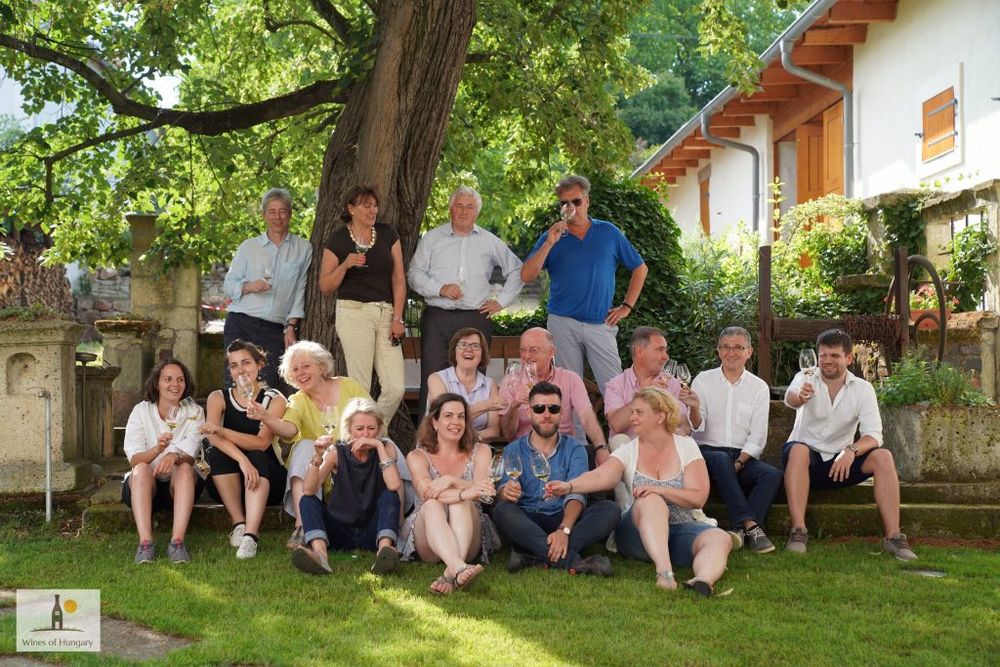Restaurant wine consultant, Peter McCombie MW, picks out the styles of wine he believes makes Hungarian wine a treasure trove of new varieties that are ideal for the premium on-trade.

Peter McCombie MW, right, down some Tokaj cellars with Oz Clarke and head of Wines of Hungary UK Lilla O’Connor, centre
Hungary has a long history of winemaking, but still faces challenges in export markets. First and foremost is its location and recent history. It’s easy, if lazy, to write off “Eastern Europe”(although Hungary is arguably Middle European and culturally distinct) and the dead hand of communist-era mediocrity ended three decades ago. Secondly are all the unfamiliar grape varieties coupled with a host of of diacritical marks and accents that make them feel impenetrable to say never mind taste. And the third challenge to overcome is quite simply Tokaj. The very success and reputation of Hungary’s fabled sweet wine casts a shadow over the rest of the country’s wines.
It feels sometimes as if Tokaj is all people know and want to know about Hungarian wine. A recent visit with UK press and buyers showed real variety and interest with wine styles that will work really well in London restaurant wine lists.
There is considerable emphasis on vineyard origin in modern Hungarian wine. Dűlő on the label indicates a cru or lieu dit. The high acid Furmint has an established reputation as the key component of sweet Tokaj, but recent vintages have produced excellent dry varietal wines, notably in Tokaj.
For example, Öreg Király Dűlő Furmint Teraszok, Barta Pince 2016 is made from low yielding bush vines grown on terraces and offers coriander seed, lemon and pepper aromas, alongside wet stones. It is super fresh in the mouth, with clean, subtle minerality, poise, freshness and is very drinkable.
The fragrant Hárslevelű, often blended with Furmint in sweet wines can make a compelling dry white varietal wine. Betsek Hárslevelű, Zsirai 2015 shows oak and age, there are nuts, lemon curd and intriguing aromas, like white Rioja with an extra floral lift; a medium bodied palate, showing peach, quince and spice overlaid with nutty evolution, fresh acidity and decent length.

Peter McCombie was part of the recent wine buyers and press study tour to Hungary
Beyond Bulls Blood
To the west of Tokaj lies Eger, known still to those of a certain vintage for Bulls Blood. Bull’s Blood remains a great if ‘creative’ story, but its vinous legacy is weak if not down right negative. These days the area hangs its hat on fresh, medium weight red and white blends, known respectively as Egri Bikavér and Egri Csillag. Bikavér literally means Bull’s Blood, but the Egri version should not be confused with the more robust style from Szekszárd in the south. If offers a good alternative to richer, riper, fuller red styles that sometimes seem better suited to competitions rather than drinking at the table.
Olaszrizling-dominated with Pinot Gris and Sauvignon Blanc, Egri Csillag, Kovacs Nimrod 2017 undergoes reductive ferment in stainless steel, producing a fresh easy drinking dry white, all grapes and nectarines. Egri Bikavér Superior, Gal Tibor 2013 contains six varieties including Kekfrankos, Kadarka, Cabernet Sauvignon, and Merlot with nothing dominating. There is savoury, earthy, spice, with some ‘sweet’ oak, it’s youthful, quite rich with some power yet fresh; sleek and smooth, yet edgy too. Dark fruit, dried herbs/seaweed and exotic spice, pleasing complexity with nothing dominating.
St Andrea’s Igazan Egri Bikavér Grand Superior 2014 from a challenging, cold vintage is more ambitious, with a fresh, darkly sophisticated nose and flavours of tamarillo. There is good density and freshness, with lovely oak-contributed spice, savoury and still a touch angular, but quite serious and gastronomic.
As well as featuring in many blends in Eger, Kékfrankos is made as a varietal here, and across the country. Egri Kékfrankos, Ostorosbor 2016 has ‘bloody’, iodiney reduction on the nose; followed by a soft, juicy, herbal-spice palate with crisp crunch. Nice easy drinking.
Click to watch highlights of the recent UK trade trip to Hungary and its key wine regions
Volcanic influence
The hill of Somló is often likened to the hill of Corton in Burgundy, yet despite some strong physical resemblances has, crucially, volcanic soils, more akin to say Etna in Sicily. It specialises in dry whites from Hungarian varieties, notably its own Juhfark. Aranyhegy Juhfark, Tornai 2015 is a single vineyard expression of this high acid grape with a hint of residual sugar for balance. It’s fresh, tasting of just-picked apricots and spices, with a lively mineral edge that carries the flavours and brings finesse and drinkability. Kolonics makes delicious varietal wines from the usual Hungarian suspects like Furmint, Hárslevelű and Juhfark, but also an impressive wine from the often under-rated Olaszrizling.
Kolonics Somloi Olaszrizling 2017 is fermented in old, steamed barrels, after a short period of skin contact producing a restrained style, with hints of flint, smoke and “volcanic-spice’ alongside, subtle stone fruit, and a palate that is youthful and firm with some power lurking. A slight phenolic grip on the finish ensures this will be useful paired with many dishes.
Not far south of Somló around the northern tip of Lake Balaton are more white wines and some reds in the tricky-to-say Balatonfüred-Csopak region. Ranolder Voros, Jásdi 2015 is a fresh smelling, herbaceousness, peppery, characteristic expression of Cabernet Franc with a rasberryish palate, mid weight, with medium, ripe tannins. Chillable and eminently gluggable.
Further down the northern coastline in Badacsony the almost extinct Kékneylű has been revived by a number of small producers. The vine only produces female flowers so must be interplanted with another variety to fertilise and produces delicately fragrant, high acid wines, like Badacsonyi Kékneylű Szaszi 2017. Spontaneously fermented in stainless steel, then aged in old oak it has a fruity floral-spice nose, pleasing sharpness and is quite dry, lightweight yet persistent. Very drinkable.
It seems counterintuitive that the grape can age well too. Szeremley Badacsonyi Kékneylű 2006 offers an intriguing mix of evolution and youthful freshness, an alluring exotic-toned minerality; rich in the mouth and full with firm acidity and slight phenolic grip. Excellent.
Down to Villány

The UK buyers’ trip was able to get a complete overview of Hungarian wine
Villány is southern Hungary has a strong reputation inside Hungary for robust and ripe reds, often from Bordeaux varieties notably Cabernet Franc. But there are fresher, lighter styles too. Fekete Járdovány, Gere Attila 2016 may be the only example of this rare grape. Fragrant, it has a whiff of pot pourri, dried cranberry and something Italianate; while the palate offers savoury and floral flavours, moderate acid, and smooth yet firm tannins and medium weight. Drinking now, it could keep too.
Kadarka is another native Hungarian, loved by some, disparaged by others. Kadarka Siller, Bock 2017 is a Central European version of clairette (siller = shimmer). Light red in colour, it smells of red fruits, tastes of red currants, some gentle crunch and a soft fruity, but dry finish. Delicious summery drinking.
There is plenty to discover in Hungary today from rich reds to delicate whites and lots of fresh tasting, medium wines of any colour. The switched on restaurateur looking for value and authenticity – and some tricky spelling – could do worse than look beyond the seductive, sweet allure of Tokaj.










































